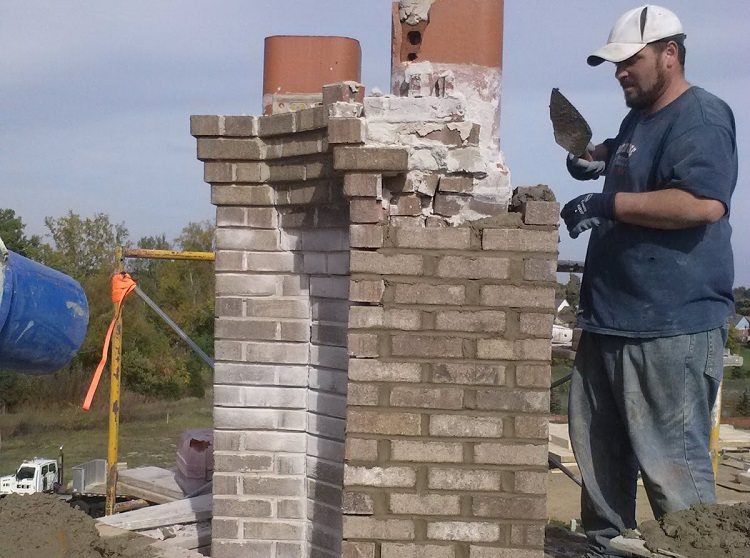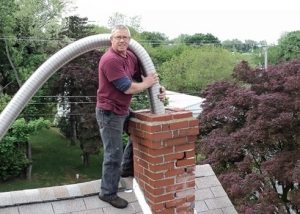Maintenance of chimneys of boiler rooms involves the identification and elimination of all kinds of damage and defects. During operation, the products are subjected to heavy loads. Chimney repairs may be necessary if they become clogged, improperly installed, worn, or upgraded to a chimney system. For industrial channels, this process is the most laborious and complex.
Content
Pipe blockages and other causes of poor performance
By type of materials and design features, boiler house chimneys are divided into the following groups:
- brick;
- metal, including stainless;
- reinforced concrete with a gas exhaust steel barrel or with an internal lining.
Clogs in the chimneys of boiler rooms worsen their draft and result from the accumulation of combustion products or industrial debris entering the pipe. The chimney draft is affected by the roughness of the inner surface of the pipe, its cross section and the integrity of the tip.
Checking for clogging with pieces of brick or concrete, soot is carried out by lowering the weight. If the blockage does not break through, then analysis of the pipe wall at the place of its formation is necessary. The accumulation of soot more than 3 mm is removed using a ruff and a weight.
Note! There are special powdered or liquid chemicals that, when burned, emit gas and clean the inside of the chimney from tar soot.

Chimney clogging occurs due to soot accumulation on its walls and then cleaning is required.
Inaccuracies during installation can lead to collapse of the structure after some time, its unnecessarily fast clogging, and the appearance of a roll. Sometimes, when upgrading a chimney system, it is necessary to install an additional headset and build up the pipe trunk or its base.
Condensation and pipe blowing
Sources of damage and the need to repair boiler house chimneys may be condensation or blowing. Condensation prevents the normal operation of heating installations. Its reasons may be the lack of insulation of the chimney, the presence of through holes and slots, cooling the attic space. In this case, the chimney must be plastered or placed in a metal case. Place heat-insulating material or slag in the space between it and the channel.
There are two reasons for blowing the chimney:
- Damage or absence of a deflector over the top of the chimney.
- The presence of tall trees or buildings near pipes that impair performance.
The deflector enhances traction by deflecting the air flow, in addition, it prevents foreign elements from entering the chimney. In the first case, it is necessary to immediately replace or repair the deflector, in the second - to increase the height of the pipe by 0.5-1 m and thereby remove it from the zone of wind backwater.
Types of repairs for industrial chimneys
Repair work on industrial smokestacks may include:
- restoration of coating, marking, anticorrosive protection of the pipe trunk;
- correction of the roll, which exceeds the maximum permissible values;
- repair and replacement of metal chimney tensioners;
- restoration of masonry trunk;
- repair of the lining of the brick chimney;
- assembly / disassembly, protection, reinforcement of heads;
- repair of blind areas;
- restoration and repair of concrete castings.
Depending on the volume and nature of the malfunction, the repair of the chimney is divided into current and capital. Overhaul of industrial chimneys of boiler rooms is carried out by specialized organizations or units, which are staffed by certified employees of the necessary qualifications. Specialists undergo a medical commission to obtain admission to work at heights.

Smokestacks for industrial use are serviced and repaired by specialists with permission for high-altitude work
The scope of work for such repairs is determined on the basis of the conclusion of the inspection of the technical condition of the pipe. This can be reinforcement or replacement of damaged or worn structures or individual parts (repair of the foundation, extension or strengthening of the pipe trunk, replacement of the lining, elements of navigation ladders, etc.).
Repairing the chimney head requires shutting down process plants. In other cases, overhaul and current repairs can be carried out in operating mode.
Chimney Examination
Assessment and inspection of the condition of boiler chimneys is carried out regularly. The control of industrial safety of the channels is carried out in accordance with the law and involves an examination, which includes such measures:
- assessment of the condition of the pipe surface, annulus, structural materials, gas flues;
- roll detection;
- calculation and assessment of the carrying capacity of chimneys.
Note! During the examination, destructive and non-destructive testing instruments are used.
The presence of defects and the nature of damage in structural elements allows us to classify the technical condition of the channels as:
- emergency (inoperative);
- limited working capacity;
- workable;
- serviceable.
Emergency chimneys exclude their subsequent operation. In this case, the bearing capacity of the structure as a whole or its elements may be lost. The limitation of the operability of industrial chimneys implies the possibility of the functioning of channels with clear operational limitations, including monitoring the state of structures, loads and effects, process parameters.
With a working technical condition of industrial boiler-house pipes, the safety requirements and the implementation of the production process are met, but there are partial violations of the rules of documents or design documentation. Serviceable smoke channels comply with all requirements of standards and regulatory documents.
Methods for repairing damage to chimneys
Based on the results of the examination, a repair project is being developed. The most common malfunctions of industrial chimneys are given in the table.
Table 1
| Damage or defect | Fixes |
| Trunks of brick and reinforced concrete pipes | |
| Masonry errors that led to a deviation from verticality | Elimination of roll by installing hydraulic jacks in special holes in the pipe |
| Deviation of the channel from the design diameter, the appearance of cracks outside the trunk | Repair of masonry involves the following operations:
1. Installation of coupling rings, as well as their tension to eliminate cracks. 2. Cracks with a width of less than 3 cm after cleaning from dirt and dust are filled with cement mortar. 3. Cracks with a width of more than 3 cm are cleared, low-quality bricks are removed, and new ones are laid in their place, moving from bottom to top. 4. After eliminating the defects of the brickwork, the compression rings are tensioned. |
| Metal chimneys | |
| The appearance of the roll. Deviation from the vertical | Tensioning cables to eliminate tilt |
| Cracks in the welded joints of the barrel | Welding at joints |
| Lining destruction | Lining restoration |
| Destruction of metal structures of stairs, anticorrosive layer of a pipe trunk | Implementation of a set of measures for cleaning and applying a new coating |
Repair of the foundation and brick chimney
In case of deformation of the base, which led to the appearance of a pipe roll, repair work includes:
- Fixing the soil by cementation, silicification or resinization.
- Foundation load on the side opposing the roll.
- Excavation on the side that resists roll.

Brick chimney may require the elimination of small cracks, and in difficult cases - a complete restoration of the masonry
When vertical and horizontal cracks appear, grouting and plastering of the foundation are performed.
Metal elements located on reinforced concrete and brick chimneys need to be repaired over time. The retaining rings must be periodically tightened, as they weaken and cease to fulfill their function. In the case of too much damage, the design changes completely.
In brick pipes, destruction begins with the tip. This is the most dangerous and weakest part of the channel. When dismantling the head, the rows of bricks break until there is no row that has not been destroyed.
Important! It is not allowed to split the walls of the pipe (cracks on the head).
Particular attention must be paid to the quality of the mortar between the bricks. Over time, it loses its properties and is washed out by precipitation. To prevent destruction, empty joints are filled with plaster mortar or special high-strength resistant dry mixes.
Repair of reinforced concrete chimneys
Reinforced concrete pipes are sometimes up to 350 meters high. To perform the work, the winch is an essential element. The iron fittings included in the pipe frame undergo corrosion. This destroys the concrete layer. If the disassembled section is more than 3 cm thick, then the embedment is performed on a metal mesh of 2 or more layers.

Brick and reinforced concrete pipes of industrial boiler rooms are sometimes restored using a layer of plaster
To improve adhesion, the surface is covered with concrete contact. Repairing the inside of the pipe may include cracking and cracking. For more complex damage, 100% surface plaster is produced.
The method of applying paint and soil is affected by the location of the painted pipe. The fastest is the use of a high-pressure apparatus. Such painting cannot be performed if the structure is located within the residential area. In this case, brushes and rollers are used.
For painting industrial concrete or brick chimneys, organosilicate paint is often used. It does not fade and is suitable for application to a metal surface.
A prerequisite for runoff is precipitation around the pipe structure. Otherwise, foundation erosion and destruction may begin.
Repair of metal pipes
The main works for metal industrial pipes are surface preparation and painting. Sometimes it is necessary to replace the bracket or other component of the smoke duct.At the preparation stage, a layer of old paint is removed. Using spatulas and metal brushes, 10 to 30% of the old coating is removed.
There are requirements to clean all 100% of the surface. This can be achieved by using a special acid solution. It is applied to the pipe and after three minutes the old coat of paint is carefully removed.
Note! Work on cleaning the pipe surface with solutions is allowed to be performed only in a gas mask.
Corrosion detection sites are treated with an anti-corrosion agent. Sometimes the surface of a metal pipe needs to be degreased. A paint layer is recommended to be applied to the primer layer with a time interval between them of about two hours.
Repair of chimneys requires high professionalism and high-quality performance of all types of work to restore their technical and operational condition.









